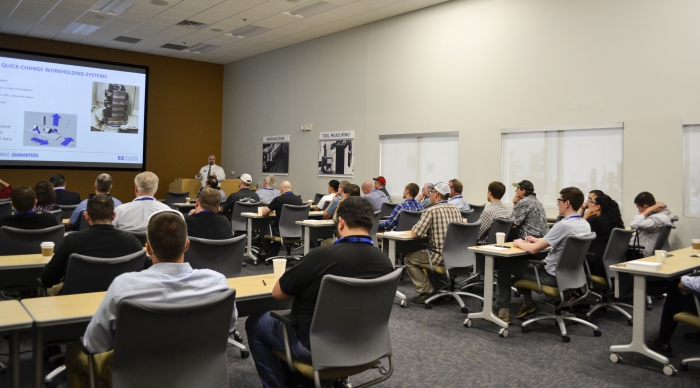BIG KAISER Precision Tooling Inc. held its Breakfast & Learn 2018 open house May 8-10 at its headquarters in Hoffman Estates, Ill. Each day included a technical presentation. On the third day, John Zaya, workholding product manager for BIG KAISER, covered multiple-axis, quick-change workholding systems.
According to Zaya, five-sided machining requires workholders that offer maximum versatility and functionality, while providing interference-free spindle-to-workpiece access.

John Zaya, workholding product manager for BIG KAISER, discusses 5-axis workholding at the Breakfast & Learn event.
Zaya said the types of machines that are suitable for 5-axis machining include a vertical machining centers with an aftermarket 4th- or 5th-axis indexer, a horizontal machining center with a B-axis and a trunnion. All of these options require three linear axes and two rotational axes. Full simultaneous 5-axis machining also requires a robust CAD/CAM package and a machine control with far look-ahead capabilities.
The spindle housing and the table size are common interference areas on a machine when 5-axis machining, he added. The housing OD limits how close the table can come to the part and the fixture. To overcome that limitation, an end user might have to extend the tool, such as by using a long-reach toolholder or elevating the workpiece further off the table. While shops often size a machine table for the largest parts they expect to produce, 5-axis machining small parts on a large table often requires long tools running at lower cutting speeds and lower DOCs. In addition, those tools are prone to chatter.
“Keep the tool length to the minimum requirement to get ‘inside’ the part,” Zaya said. There are a variety of 5-axis workholding systems, including standard vises, tall-jaw and modular vises, he said. The tall-jaw style may provide sufficient vertical clearance, but it also may sacrifice holding force. It’s important to have the clamping force as close to the workpiece as possible to prevent the workpiece from slipping or moving while maintaining repeatability.
Zaya added that modular vises are adjustable to part size changes, can elevate a part and keep the clamping force close to the workpiece.
In addition, monolithic and/or modular risers offer a common workholding method to access a workpiece when 5-axis machining, he said. They are commercially available but users often make their own risers. BIG KAISER’s 5-axis modular stacking system provides similar functionality.
Zaya emphasized that although more axes complicates workholding, quick-change solutions are available to those who are flexible, and “… the mindset from the 3-axis world doesn’t always work in 5-axis machining.”
Related Glossary Terms
- centers
centers
Cone-shaped pins that support a workpiece by one or two ends during machining. The centers fit into holes drilled in the workpiece ends. Centers that turn with the workpiece are called “live” centers; those that do not are called “dead” centers.
- chatter
chatter
Condition of vibration involving the machine, workpiece and cutting tool. Once this condition arises, it is often self-sustaining until the problem is corrected. Chatter can be identified when lines or grooves appear at regular intervals in the workpiece. These lines or grooves are caused by the teeth of the cutter as they vibrate in and out of the workpiece and their spacing depends on the frequency of vibration.
- clearance
clearance
Space provided behind a tool’s land or relief to prevent rubbing and subsequent premature deterioration of the tool. See land; relief.
- fixture
fixture
Device, often made in-house, that holds a specific workpiece. See jig; modular fixturing.
- look-ahead
look-ahead
CNC feature that evaluates many data blocks ahead of the cutting tool’s location to adjust the machining parameters to prevent gouges. This occurs when the feed rate is too high to stop the cutting tool within the required distance, resulting in an overshoot of the tool’s projected path. Ideally, look-ahead should be dynamic, varying the distance and number of program blocks based on the part profile and the desired feed rate.
- machining center
machining center
CNC machine tool capable of drilling, reaming, tapping, milling and boring. Normally comes with an automatic toolchanger. See automatic toolchanger.
- outer diameter ( OD)
outer diameter ( OD)
Dimension that defines the exterior diameter of a cylindrical or round part. See ID, inner diameter.
- toolholder
toolholder
Secures a cutting tool during a machining operation. Basic types include block, cartridge, chuck, collet, fixed, modular, quick-change and rotating.

